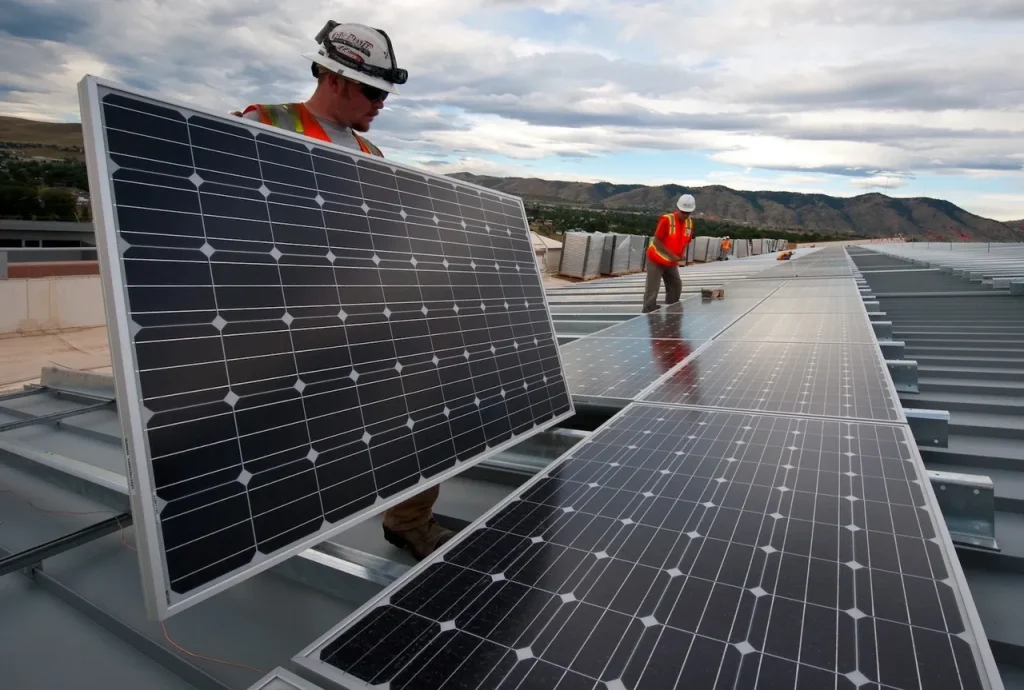Solar projects on a global scale are getting cheaper and more investment-worthy while also providing customers with more efficiency on a per-watt basis. These projects range from large utility-scale megaprojects to small residential deployments.
Solar Systems for Residential and Commercial Buildings
Solar projects on a global scale are getting cheaper and more investment-worthy while also providing customers with more efficiency on a per-watt basis. These projects range from large utility-scale megaprojects to small residential deployments.
Understanding Commercial Use
Utility-scale Solar PV Projects
Solar projects are of the ‘utility-scale’ variety if they generate 10 megawatts (MW) or more of usable electricity. For the sake of comparison, an American home’s typical monthly electricity use is roughly 900 kWh (0.9 MWh).
Solar power on a utility scale can be combined with energy storage to control evening energy ramping, supply backup power, and perform other functions. Primary photovoltaics (PV) or concentrated solar power are two of the solar technologies that could be used in a solar power plant on an industrial or utility scale (CSP). Both the size of the project and the fact that the electricity is sold to wholesale utility buyers, as opposed to end-use users, are what set utility-scale solar apart from distributed generation. Distributed generation refers to solar power that is produced by individual homeowners. Utility-scale solar facilities offer the benefit of power at a fixed price during peak demand periods, which are times when electricity generated from fossil fuels is the most expensive.
What are some similarities between L’Oreal, Google, and Target? All three have established themselves as leaders in the private sector in terms of the deployment of commercial solar energy.
Stakeholders are becoming more aware of the potential cost savings that solar power operations can bring. Industries that focus on consumer products, fashion, and the high-tech sector all require considerable amounts of energy. They are also becoming aware of the intangible benefits that come along with meeting the expectation of customers that the company will be environmentally conscious.
Building-integrated photovoltaics
Building-integrated photovoltaics, or BIPV, projects are becoming increasingly popular as a solution that enables architects to enhance energy efficiency by integrating solar panels in empty commercial window space. This allows for the maximum amount of sunlight to enter the building.
Solar technology companies have been the target of criticism in the past due to the fact that they delivered designs for solar arrays that were an “eyesore.” This criticism was taken into consideration when developing BIPV. In addition to this, it is currently one of the subfields of the solar business that is expanding at the quickest rate.
Solar carports
The installation of solar carports is an additional efficient method that may be utilized in the construction of commercial buildings to improve the buildings’ energy efficiency. Constructing solar carports is one way to use solar panels for business projects. The parking lot of Atlanta’s Mercedes-Benz stadium, which in 2018 played host to both the U.S. College Football Championship Game and Super Bowl LIII, is outfitted with solar panels in a significant portion of its total surface area.
Solar installations on rooftops and ground-mounted arrays continue to be the most popular choices for Commercial and Industrial (C&I) construction projects. Compared to utility-scale projects, the size of these types of projects is typically much smaller, typically falling between 1 and 2 megawatts (MW). The off-taker is another critical factor that differentiates C&I projects from utility-scale ones. Utility-scale projects are geared mainly toward serving the needs of utility companies, whereas C&I projects are primarily focused on supplying power to corporate organizations and industrial operations.
Understanding Residential Use
In certain States, like California and Texas, the residential sector is the solar PV project segment that is developing at the quickest rate. Evidence shows that solar system significantly reduce the electricity bill for home owners.
The minor forms of solar photovoltaic systems are those installed on residential rooftops, with capacities ranging from 5 to 20 kilowatts (0.005-0.2MW). Installers of residential solar panels will often need a feasibility analysis before beginning the installation process with engineers. This study will establish essential criteria such as the total shade-free area, the amount of insolation, the potential power production, the ideal panel orientation, roof structure framing support and solar panel attachment connection design.
Differences Between the Two Types
Solar power is becoming an increasingly attractive alternative energy source for homeowners and business owners alike. Solar energy systems are classified as either residential or commercial depending on their efficiency, size, ease of installation, and color. These are the four primary factors that differentiate the two.
1. Solar energy produced by commercial installations is approximately 2 percent more efficient than solar energy produced by residential installations. In addition, the panels used in commercial solar power generation are far more extensive than those used in residential solar power generation. Due to the fact that we determine the cost of solar panels based on the amount of power they generate, a 4-kilowatt system installed on a residential property will have the same price tag as a commercially installed system.
2. Measurements Commercial solar panels, on average, have a more extensive surface area than household solar panels do. A solar panel system for a residential property typically has 72 cells and measures 65 inches by 39 inches. In contrast, a solar panel system for a commercial property often has 96 cells and measures 78 inches by 39 inches. In the event that residents are okay with the size of the solar panels, commercial-scale systems can be installed. Solar panels designed for commercial use generate more power and are more efficient; as a result, you should give serious consideration to installing them in your home.
3. Installation – When we install solar panel systems, whether they are for personal or commercial use, we employ the same method, which is to use a bolted racking system. The majority of residential roofs are pitched. However, business roofs are often flat, which makes the installation process much simpler. In contrast, the installation of solar panels on a residential roof often takes only one or two days, while the completion of a commercial system can take as long as a month.
4. Color: While solar panel systems for commercial use are typically white in color, home systems can be either black or white. The majority of the time, residential clients choose black panels on black backing, whereas commercial customers prefer black panels on white backing. Your choice of hue should be based on what appeals to your sense of style.
One thing both residential and commercial solar power systems have in common, despite the fact that there are a number of ways in which they differ from one another, is that they both help to preserve the environment. Please contact Superb Engineer if you need any engineering support for your solar project.



